You can preserve food naturally using sugar-based methods that don't require artificial chemicals. Start with basic sugar solutions, ranging from light (20%) to heavy (50%) concentrations, depending on what you're preserving. Honey offers a powerful alternative with its natural antibacterial properties and low moisture content. For fruits and vegetables, try making fruit syrups or using the dehydration method with sugar coating. Traditional sugar curing works well for specific foods, while combining sugar with natural acids like lemon juice enhances preservation power. These time-tested techniques hold centuries of wisdom waiting to be rediscovered in your kitchen.
Raw Sugar Food Preservation Methods
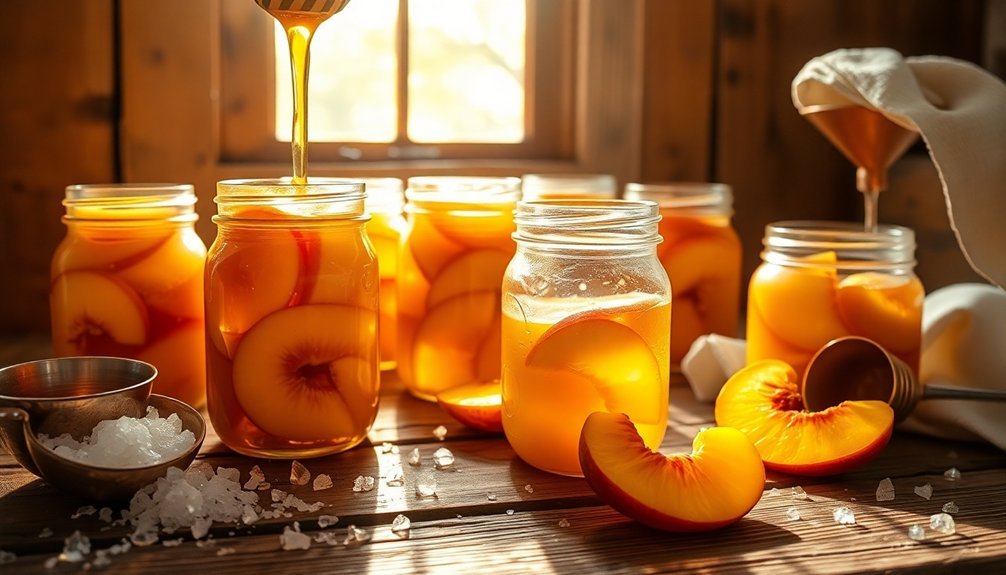
Raw sugar preservation starts with selecting the right storage environment and containers.
You'll need to choose a cool, dry location away from direct sunlight and heat sources. Don't place your sugar in the refrigerator, as the moisture content can cause problems. Its unique molasses content makes raw sugar particularly sensitive to moisture exposure.
For effective storage, you'll want to use airtight, moisture-proof containers. Glass jars, food-grade plastic containers, or ceramic canisters work well for smaller quantities.
If you're storing bulk amounts, consider food-grade buckets with gamma seal lids or Mylar-type bags. Make sure your containers are completely clean and dry before adding sugar.
To prevent clumping and maintain quality, add desiccant packets to your storage containers. You can also use oxygen absorbers with mylar bags for long-term preservation.
If your sugar does clump, you can break it up gently or briefly warm it to restore its texture.
When stored properly, raw sugar can last indefinitely.
While manufacturers often include a "best by" date of 18 months to 2 years, your sugar will remain safe to consume even beyond this timeframe.
Though it may experience slight changes in color or taste over time, its preservation qualities remain intact.
Honey Based Preservation Techniques
You can tap into one of humanity's oldest preservation methods by using honey, which ancient Egyptians utilized to store foods for thousands of years.
For optimal safety, fully dehydrated fruits work best when preserving in honey since they introduce minimal moisture into the mixture.
Honey's powerful natural antibacterial properties come from its low moisture content, acidity, and production of hydrogen peroxide, making it an effective preservative for many foods.
When you're working with fruits in honey, you'll want to use appropriate syrup concentrations and guarantee proper sealing to prevent moisture absorption that could compromise the preservation process.
Ancient Honey Storage Methods
Throughout ancient civilizations, honey proved to be one of nature's most remarkable preservatives, with evidence of its effectiveness spanning from Ancient Egypt to Rome.
You'll find examples of honey's preservative power in King Tutankhamun's tomb, where honey-preserved foods remained unspoiled for thousands of years. The Romans and Greeks perfected preservation techniques by combining honey with quince, cooking the mixture until it achieved a solid texture for extended storage.
This practice aligned with early civilizations' need to store food supplies beyond immediate consumption, ensuring survival during lean times.
Ancient storage methods were carefully developed to maintain honey's preservative qualities:
- Storage containers were chosen with precision – glass and pottery vessels were preferred over metal, as honey's natural acidity could cause rusting.
- Temperature control was essential, with cool, dry locations being ideal to prevent crystallization and maintain quality.
- Airtight sealing was vital, as moisture could lead to fermentation.
In West Africa, the Nok people demonstrated sophisticated honey storage methods using specialized pottery vessels.
Similarly, in northern regions where sun-drying wasn't feasible, people developed techniques combining honey with sugar to create preserves.
These ancient methods laid the groundwork for modern food preservation techniques and continue to influence how we store honey today.
Honey's Natural Antibacterial Properties
Building upon these ancient storage methods, honey's remarkable preservative power stems from its complex antibacterial properties. You'll find that honey's effectiveness comes from multiple natural mechanisms working together to prevent bacterial growth. Its extremely low moisture content and high sugar concentration create an environment where bacteria simply can't survive, as the osmotic effect pulls water from microbial cells.
When you're using honey as a preservative, you're taking advantage of its unique chemical makeup. The natural acidity, with a pH between 3 and 4.5, makes it impossible for most harmful microorganisms to thrive.
You're also benefiting from honey's hygroscopic nature, which means it actively absorbs moisture from its surroundings, further dehydrating any bacteria that might be present.
You'll notice honey's superiority over other sugars when it comes to preservation. While table sugar only offers osmotic protection, honey provides additional safeguards through its hydrogen peroxide production and polyphenol content.
When you coat food with honey, you're creating a protective seal that not only prevents contamination but also maintains the food's nutritional value, making it an excellent natural alternative to chemical preservatives.
Combining Honey With Fruits
Three proven techniques stand out when combining honey with fruits for long-term preservation: osmotic dehydration, direct coating, and fermentation.
When you use the osmotic dehydration method, you'll partially dehydrate fruits in honey before gentle drying, keeping their natural flavors intact while ensuring they stay shelf-stable for up to a year in vacuum-sealed polyethylene bags.
The coating technique lets you seal fruits directly in honey using pressure or centrifugal methods. You'll find this approach works well for both fresh and already-dried fruits, as honey's natural antibacterial properties prevent rotting at room temperature.
For fermentation, you'll need to mix raw honey with fruits and water, using at least 8% honey concentration. While this method requires extra attention to prevent mold, you can slow the fermentation by refrigerating after a few days.
- All three methods result in preservative-free, healthy snacks that maintain their quality during storage
- You can use the preserved fruits in desserts or other recipes
- Each technique allows for convenient storage at room temperature when properly packaged
Fruit Syrup Storage Solutions
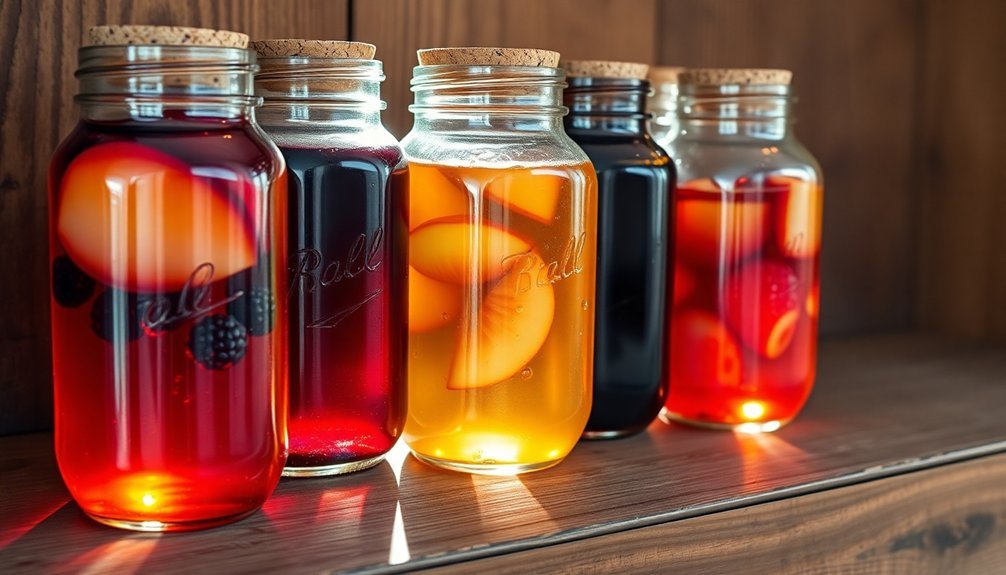
When storing homemade fruit syrups, you'll need to contemplate both preservation methods and sugar concentration levels to maximize shelf life.
Start by choosing between refrigeration, which keeps your syrup fresh for a few weeks, or freezing, which extends storage up to six months.
For longer preservation, you'll want to use a rich syrup ratio of 2-to-1 sugar to water, which can keep your syrup viable for up to six months in the fridge.
You can further enhance preservation by creating an invert syrup – heat it to 240 degrees and add cream of tartar or lemon juice. Aim for a brix measurement of at least 50 to reduce water availability to microorganisms.
If you're planning for extended storage, sterilize your jars and lids in boiling water (20 minutes for jars, 10 for lids).
After filling them with hot syrup, create a vacuum seal through a second sterilization. You can also add natural preservatives like citric acid or lemon juice to create an acidic environment.
For maximum effectiveness, combine these methods – use a rich syrup ratio in sterilized jars with natural preservatives, and you'll achieve the longest possible shelf life.
Sugar Curing Traditional Practices
Traditional sugar curing requires precise temperature control and careful attention to ingredient ratios for ideal preservation. You'll need to maintain temperatures between 36-40°F (2-5°C) throughout the process, as lower temperatures interfere with salt penetration while higher ones risk spoilage.
For your curing mixture, combine 4 pounds of non-iodized salt, 1.5 pounds of sugar, and 3 ounces of saltpeter.
When you're ready to begin, you'll apply the cure mixture directly to your meat using specific ratios:
- For hams: Use 1.25-1.5 ounces of cure mix per pound
- For bacon: Apply 0.75-1 ounce of cure mix per pound
For timing: Calculate 7 days per inch of meat thickness.
You'll need to store your meat in a sanitized, cold environment throughout the curing process. If temperatures drop below freezing, add those days to your total curing time.
Once curing is complete, rinse off excess salt and cook the meat before eating – it'll turn pink or reddish when properly cooked. Remember to store your finished product under refrigeration to allow the salt to distribute evenly and help dry the meat.
Combining Sugar With Other Preservatives
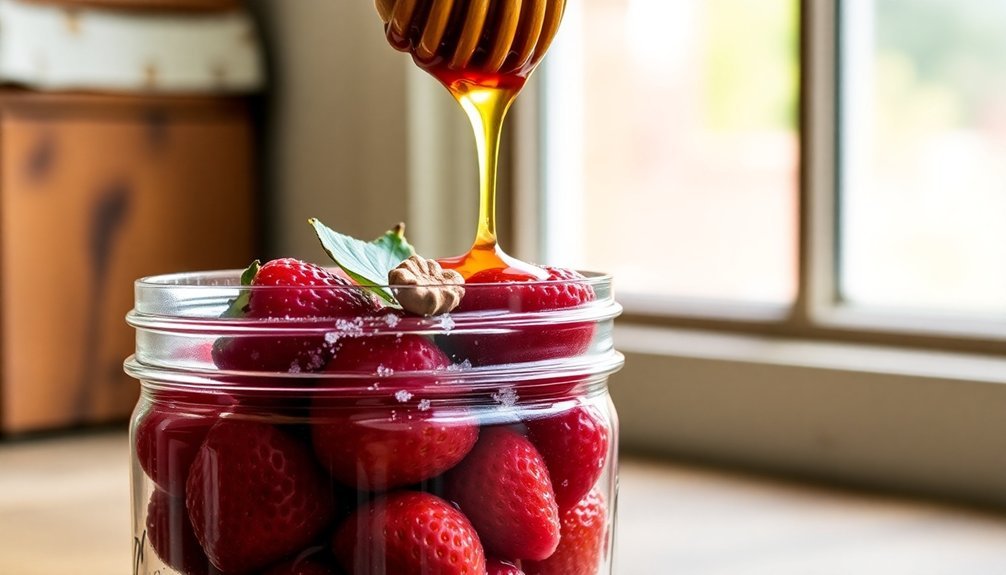
Building on basic sugar curing methods, combining sugar with other preservatives can markedly enhance food preservation effectiveness. When you combine sugar with other preservation techniques, you'll create a more robust preservation system that works through multiple mechanisms.
Sugar reduces water activity through osmosis, while acids and heat treatment provide additional barriers against spoilage.
You'll find that sugar works particularly well with acidic preservatives, especially in jams and jellies. By combining sugar with ascorbic acid, you can maintain the appearance and quality of preserved fruits while ensuring better shelf stability.
Hot filling techniques paired with sugar will give you ideal results by eliminating initial microbial contamination.
If you're looking to reduce sugar content, you'll need to make some adjustments. While artificial sweeteners are safe to eat, they won't provide the same preservative benefits as natural sugar.
You can safely preserve fruits with less sugar by using water or fruit juice, but expect a shorter shelf life of about 6 months instead of a year. For low-sugar preserves, you'll want to use refrigeration or freezing to maintain quality and prevent spoilage.
Dehydrating Foods Using Sugar
Several effective sugar-based dehydration methods can extend your food's shelf life while preserving its taste and texture. When you use sugar in dehydration, it attracts water molecules away from bacteria, creating an environment where harmful microorganisms can't survive.
You'll find that foods with higher sugar content don't need to be as dry to stay preserved, making the process more flexible.
You can choose from these proven sugar-based methods:
- Honey dip: Create a solution of sugar and boiling water, add honey, then soak your fruits for 3-5 minutes before drying
- Direct sugaring: Dehydrate your food first, then pack it with pure sugar to maintain preservation
- Ascorbic acid mixture: Combine sugar with ascorbic acid solution for better color retention and preservation
When you're dehydrating with sugar, you'll notice it helps maintain color, texture, and flavor better than drying alone.
For long-term storage, consider using corn syrup or honey instead of granulated sugar, as they won't form crystals. While vegetables need thorough drying, fruits with high sugar content can retain some chewiness and still stay preserved, giving you more flexibility in your food preservation efforts.
Sugar Ratios for Food Storage
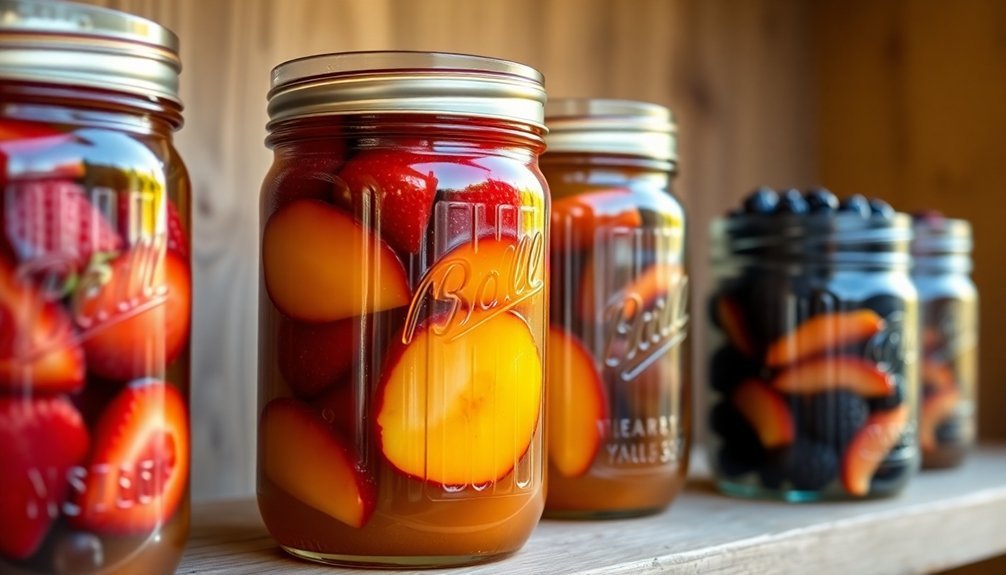
Understanding proper sugar ratios marks the difference between successful and failed food preservation. When you're preserving fruits, you'll need to choose between five sugar concentrations: very light (10%), light (20%), medium (30%), heavy (40%), or very heavy (50%).
You'll create these concentrations by mixing sugar with water in specific proportions, such as 1 cup sugar to 4 cups water for a light syrup.
You'll want to reflect on that using less sugar can compromise your fruit's texture, color, and shape. While it's possible to preserve fruit with reduced sugar content, you'll need to be prepared for potential quality changes.
If you're looking to cut down on sugar, you can replace up to one-fourth of it with corn syrup or honey without compromising food safety.
Sugar's preservative properties are essential for maintaining food quality and safety. It helps prevent microbial growth and maintains the fruit's texture and flavor.
If you're concerned about using less sugar, you can add ascorbic acid as a pre-treatment to help maintain the fruit's appearance.
Sweet Preserves Without Additives
Making sweet preserves without additives offers a healthier alternative to traditional sugar-packed recipes. You'll find that natural sweeteners like fruit juice, honey, and maple syrup can create delicious preserves while maintaining nutritional value.
When you're looking to reduce sugar content, chia seeds work as an excellent thickener, allowing you to use less sweetener overall.
For successful additive-free preserves, consider these essential elements:
- Natural pectin sources like apples and citrus fruits eliminate the need for commercial additives
- Small-batch preparation allows better control over sweetness and consistency
- Proper storage methods, including refrigeration or freezing, help maintain freshness
You can expect some texture and flavor differences when using natural sweeteners, as they behave differently from refined sugar during the preservation process.
While your preserves might've a softer consistency, they'll retain more of the fruit's natural taste. Remember that these sugar-free versions typically have a shorter shelf life than traditional preserves, so it's best to make smaller batches and store them properly.
For long-term storage, you'll need to use the boiling water method, adjusting for your altitude as needed.
Sugar Crystal Preservation Process
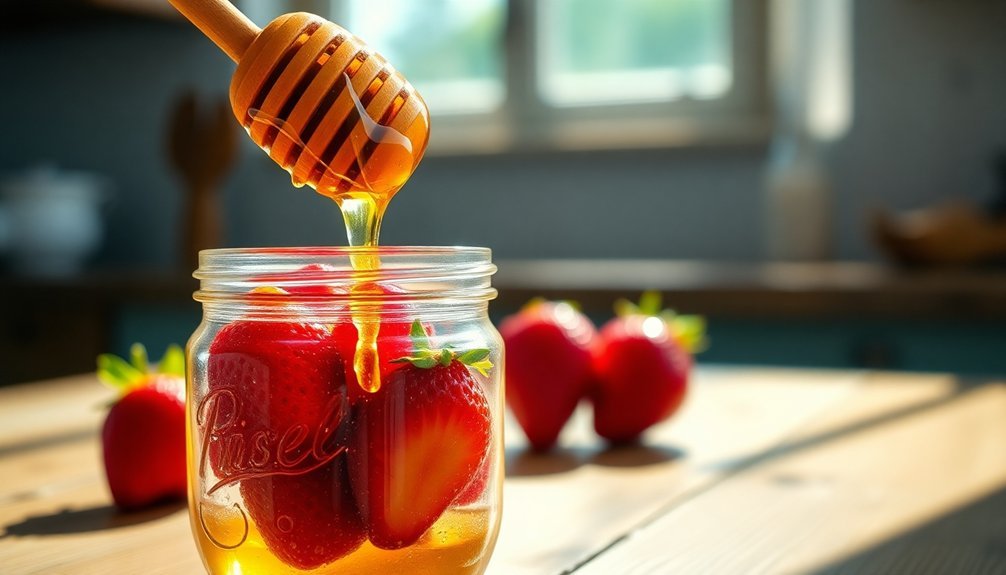
You'll find success in creating protective sugar crystal coatings by carefully layering multiple applications while maintaining proper sugar density ratios in your preservation solutions.
To achieve ideal crystallization, you must store your preparations in a temperature-controlled environment between 65-75°F, away from direct sunlight and moisture.
Your monitoring of sugar concentration and temperature throughout the process will guarantee consistent crystal formation and long-term preservation effectiveness.
Creating Sugar Crystal Coatings
The art of sugar crystal coating transforms ordinary confections into long-lasting treats through a precise preservation process.
You'll need to start with completely dry candies that have aged for 24 hours before coating them. Place your candies in a mesh basket, then submerge them in a cooled supersaturated sugar solution maintained between 65° and 80° F.
You've got two main methods to choose from: a 6-hour soak or sugar panning. The soaking method requires complete submersion under a covered solution, while panning involves multiple dipping and drying cycles over 1.5 to 2 hours to build up crystalline layers.
- Maintain ideal drying conditions of 60-70°F with 45% relative humidity
- Wipe excess moisture from each piece by hand after coating
- Store unpackaged candies at 50-70°F with 25-45% relative humidity
After coating, you'll need to dry the candies for 24 hours using screen trays. You can speed up this process with fans or dehumidifiers.
When done correctly, your crystal-coated candies will last 9 to 12 months, protected from both moisture and dehydration thanks to their protective sugar shell.
Sugar Density For Preservation
Through precise sugar density control, successful food preservation depends on reducing water activity to inhibit microbial growth. You'll need to grasp that sugar works by absorbing water from food, creating an environment where bacteria can't multiply. This osmotic effect disrupts microbial enzymes and weakens their DNA structure, effectively extending your food's shelf life.
You can use various sugar types for preservation, including table sugar, honey, molasses, or invert syrups. Each type affects your final product's texture and flavor differently, so choose based on your preservation needs.
When you're preserving fruits, vegetables, or making jams and jellies, you'll want to maintain specific sugar concentrations to guarantee proper preservation.
If you're looking to reduce sugar content, you'll need to take into account alternative preservation methods. While artificial sweeteners exist, they won't provide the same preservative effects as natural sugars. You can try using fruit juices or ascorbic acid pre-treatments, but be aware that FDA-approved preservatives might be necessary for reduced-sugar products.
Temperature Control For Crystallization
Successfully controlling crystallization temperatures requires careful attention to specific ranges and cooling methods. You'll find that the ideal temperature range falls between 70°C and 90°C, where supersaturation creates the perfect environment for crystal formation. When you're working with sugar solutions, maintaining temperatures around 78°C will give you the best results for controlled crystallization.
Here's what you need to know about temperature's impact on crystal formation:
- Higher temperatures (around 112°C) are ideal for initial cooking, leading to larger, well-shaped crystals when combined with moderate supersaturation.
- Cooling below 70°C slows the process due to increased viscosity, so you'll want to avoid dropping below this threshold.
- Controlled cooling in stages produces the highest quality crystals, especially when you're using agitation techniques.
For successful crystal preservation, you'll need to manage the cooling process carefully. Using a systematic approach with controlled temperatures will help you achieve the desired crystal size and quality.
Remember that rapid temperature changes can inhibit crystal formation, so it's crucial to maintain steady control throughout the process. You can monitor the temperature using basic thermometers or more sophisticated electronic control modules depending on your setup.
Traditional Sugar Conservation Approaches
Ancient civilizations pioneered sugar-based preservation methods that we still rely on today. Greeks and Romans discovered that mixing fruits with honey created lasting preserves, with the Romans advancing the technique by cooking quince and honey together to achieve a firmer consistency.
When sugar cane made its way to Europe through trade routes, it revolutionized food preservation practices.
You'll find that sugar's preservation power comes from its ability to draw water out of food through osmosis. When you combine fruit with sugar and heat the mixture, you're creating an environment where harmful microorganisms can't survive. This process is vital for making jams, jellies, and preserves that'll keep for extended periods.
You can use several traditional sugar preservation methods in your kitchen. Try sugaring, where you'll either submerge fruit in sugar syrup or coat it with crystallized sugar.
When making preserves, you'll need to combine fruit with substantial amounts of sugar and boil the mixture. While you might be tempted to reduce sugar content, remember that it's essential for both preservation and maintaining proper texture, color, and flavor in your preserved foods.
Frequently Asked Questions
Can Sugar-Preserved Foods Be Safely Consumed by Diabetics?
You can eat sugar-preserved foods if you have diabetes, but you'll need to carefully monitor portions and count them in your daily carbohydrate allowance. It's best to choose options with less added sugar.
How Does Altitude Affect Sugar Preservation Techniques?
You'll find that altitude doesn't greatly affect sugar's preservation abilities. While you'll need to adjust cooking temperatures and times, sugar's osmotic properties and ability to prevent microbial growth remain constant at any elevation.
Why Do Some Sugar-Preserved Foods Crystallize While Others Don't?
You'll notice crystallization depends on how you handle sugar's concentration and temperature. When you mix different sugar types or add acids, you prevent crystals from forming, while single-sugar solutions crystallize more readily.
Does Artificial Sweetener Work as Effectively as Natural Sugar for Preservation?
No, you can't rely on artificial sweeteners for effective preservation. They don't provide the same preservative properties as natural sugar, won't maintain texture and color, and may require refrigeration for safety.
Can Mold Develop in Sugar-Preserved Foods Stored at Room Temperature?
Yes, mold can grow in your sugar-preserved foods at room temperature if there's too much moisture present. You'll need proper dehydration, airtight containers, and consistent storage conditions to prevent mold development.
In Summary
You've now learned multiple ways to preserve food using natural sugars without artificial additives. Whether you're using raw sugar, honey, or fruit syrups, you'll find these traditional methods both effective and chemical-free. Remember to maintain proper sugar ratios and combine techniques when needed. By following these time-tested preservation approaches, you can store your food naturally while keeping its authentic flavor intact.
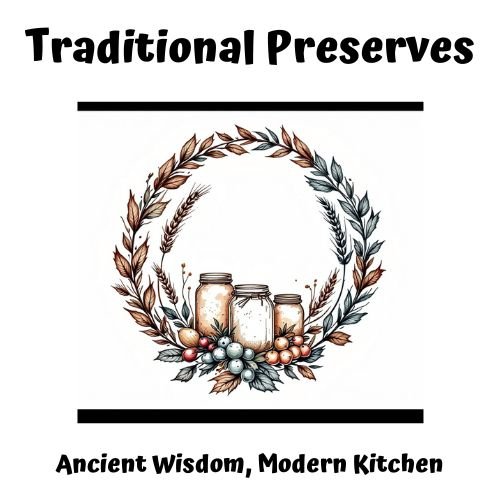

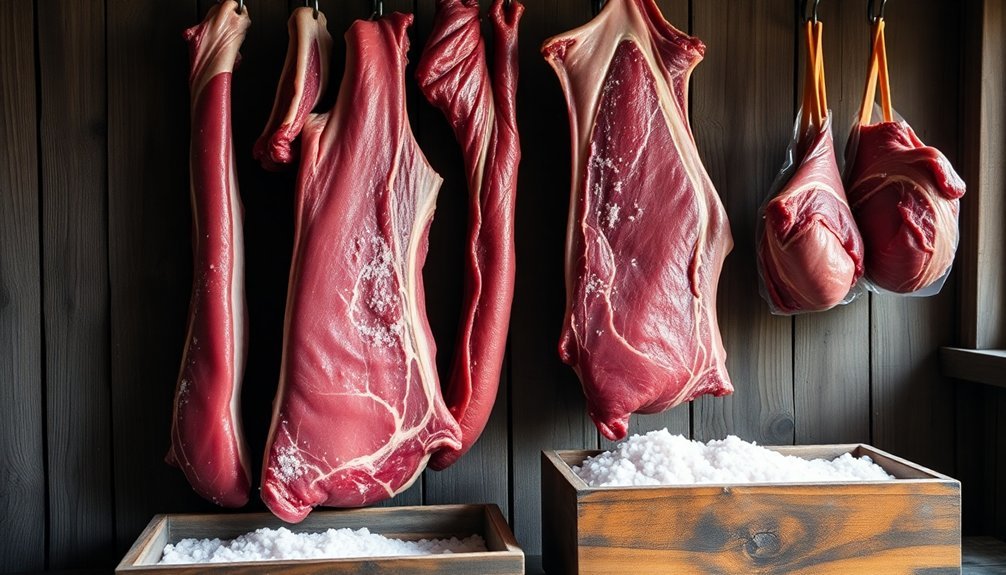
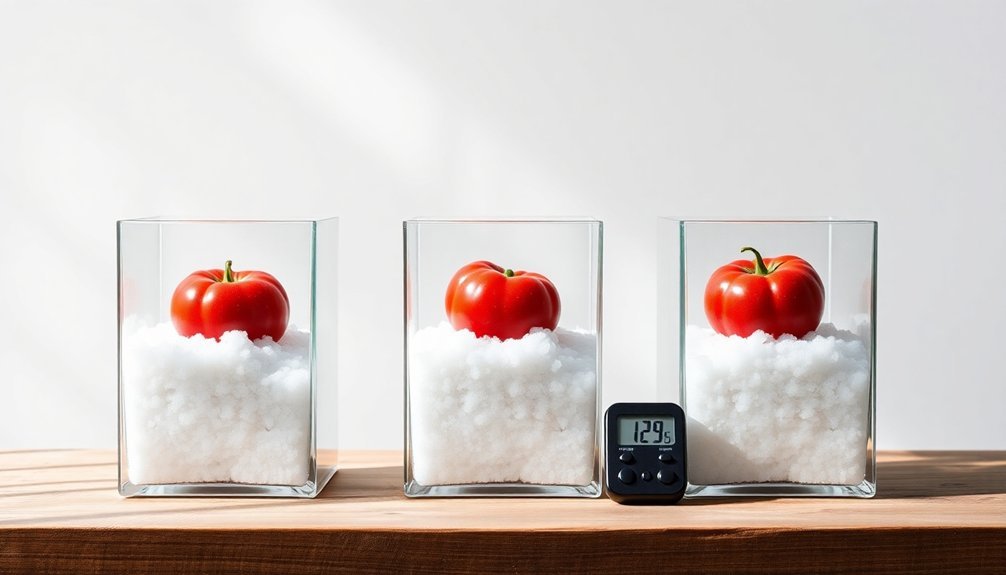
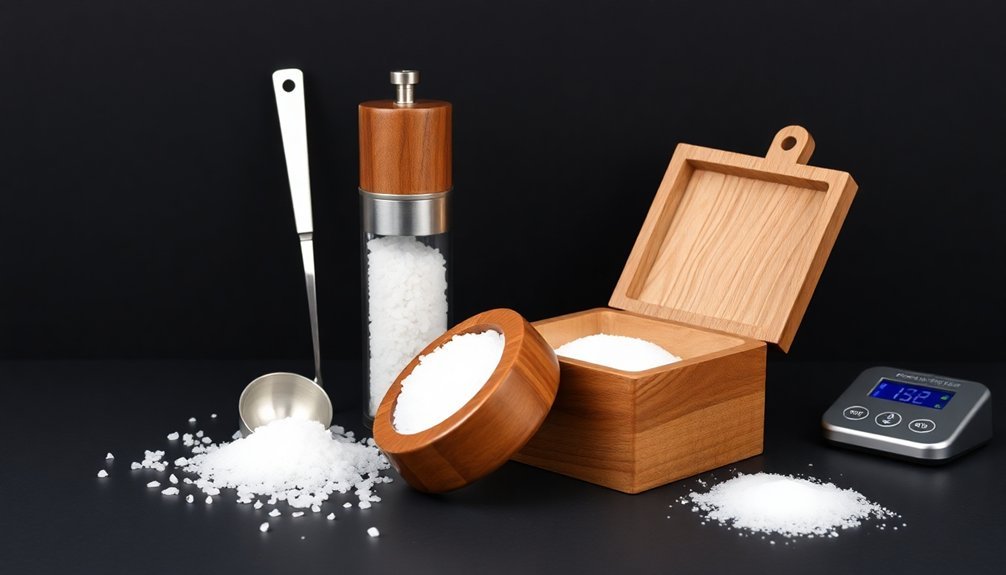
Leave a Reply